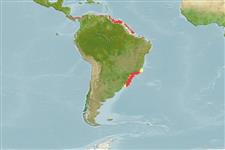Elasmobranchi (squali e razze) (sharks and rays) >
Carcharhiniformes (Ground sharks) >
Scyliorhinidae (Cat sharks)
Etymology: Scyliorhinus: Greek, skylla = a kind of shark + Greek, rhinos = nose (Ref. 45335).
Ambiente / Clima / Range
Ecologia
; marino demersale, usually 37 - 402 m (Ref. 107325). Deep-water, preferred ?; 11°N - 32°S
Western Atlantic: coast of Venezuela to Brazil, Amapá state (confirmation needed) and from northern Rio de Janeiro state to Argentina.
Length at first maturity / Size / Peso / Age
Maturity: Lm ?, range 40 - ? cm
Max length : 60.0 cm TL maschio/sesso non determinato; (Ref. 57911); 50.9 cm TL (female); common length : 25.0 cm TL maschio/sesso non determinato; (Ref. 5217)
Short description
Morfologia | Morfometria
This species is distinguished by the following characters: triangular or squared tipped first dorsal fin (vs. never squared tipped in S. ugoi, S. cabofriensis); neurocranium with a narrow basal plate (vs. broad in S. cabofriensis); color pattern with saddles not delineated by light or dark spots (vs. delineated by light or dark spots in S. boa); saddles darker than background color and lacking sharp median projections (vs. saddles indistinct S. cabofriensis, S. boa, with sharp median projections in S. ugoi); spots large and small, sometimes sickle-shaped or lunate and with clear centers on the back and sides, arranged in approximate bilateral symmetry, and sometimes present in intersaddle regions (vs. spots spiracle-sized, randomly distributed, not sickle-shaped or lunate in S. cabofriensis); rounded and short snout, preoral length 4.5% TL (vs. 5% TL in S. ugoi, S. cabofriensis); short and depressed head, length 17.5-19.2% TL (vs. 19.7-20.8% in S. cabofriensis; 19.5-20.3% in S. ugoi); interdorsal space 1.2-2 times dorsal-caudal space (vs. 2 times in S. cabofriensis; 2.1-2.5 in S. ugoi); claspers with ventral terminal cartilage 2 slender and positioned above ventral terminal cartilage, length 1.8 times in ventral terminal cartilage (vs. 1.5 times in S. cabofriensis); ventral terminal cartilage without a prominent groove posteriorly or with shallow and poorly developed groove (vs. groove well developed in S. cabofriensis); small-sized, adult males at about 35.3 cm TL, adult females at about 41.5 cm TL (vs. 44.5 cm and 50.0 cm TL, respectively, in S. ugoi) (Ref. 107325).
This species is reported to be associated with coral or calcareous algal formations where it possibly lays it egg-capsules. Stomach contents include squid beaks and skeletal elements of bony fishes. Reported males with well-developed claspers at about 35.3 cm TL; females as adults from 41.5 cm TL. Egg-capsules observed to have light amber to yellowish colour, without longitudinal grooves and measure about 6.0 cm in length, 2.5 cm in width (Ref. 107325). Found on the continental shelf and upper slope. Oviparous. Not utilized at present (Ref. 244).
Life cycle and mating behavior
Maturità | Riproduzione | Deposizione | Uova | Fecundity | Larve
Oviparous, paired eggs are laid. Embryos feed solely on yolk (Ref. 50449).
Compagno, L.J.V., 1984. FAO Species Catalogue. Vol. 4. Sharks of the world. An annotated and illustrated catalogue of shark species known to date. Part 2 - Carcharhiniformes. FAO Fish. Synop. 125(4/2):251-655. Rome: FAO. (Ref. 244)
IUCN Red List Status (Ref. 115185)
CITES (Ref. 94142)
Not Evaluated
Threat to humans
Harmless
Human uses
Pesca: di nessun interesse
Informazioni ulteriori
Age/SizeAccrescimentoLength-weightLength-lengthLength-frequenciesMorfometriaMorfologiaLarveDinamica popolazioni larvaliReclutamentoAbbondanza
BibliografiaAcquacolturaProfilo di acquacolturaVarietàGeneticaFrequenze allelicheEreditarietàMalattieElaborazioneMass conversion
CollaboratoriImmaginiStamps, CoinsSuoniCiguateraVelocitàModalità di nuotoArea branchialeOtolithsCervelliVista
Strumenti
Special reports
Download XML
Fonti Internet
